
The Book of Hebrews
|
Hebrews Chapter 9 |
|
Hebrews Chapter 9: The New Covenant
In chapter 9, the author of Hebrews reveals how the Tabernacle a parable or symbol only to be fulfilled in Christ. Hebrews 9 1 Then indeed, even the first covenant had ordinances of divine service and the earthly sanctuary. 2 For a tabernacle was prepared: the first part, in which was the lampstand, the table, and the showbread, which is called the sanctuary; 3 and behind the second veil, the part of the tabernacle which is called the Holiest of All, 4 which had the golden censer and the ark of the covenant overlaid on all sides with gold, in which were the golden pot that had the manna, Aaron's rod that budded, and the tablets of the covenant; 5 and above it were the cherubim of glory overshadowing the mercy seat. Of these things we cannot now speak in detail. 6 Now when these things had been thus prepared, the priests always went into the first part of the tabernacle, performing the services. 7 But into the second part the high priest went alone once a year, not without blood, which he offered for himself and for the people's sins committed in ignorance Worship in the earth Tabernacle
Verses 1-7 First Covenant: The Mosaic Covenant, instituted on Mt. Sinai, was part of God’s divine plan. The law accomplished two things, 1. The law (First Covenant) was illustration or shadow of the coming of Messiah, who would fulfill the picture. 2. The Mosaic Law demonstrated man’s inability to attain righteousness through obedience. 19 Now we know that whatever the law says, it says to those who are under the law, that every mouth may be stopped, and all the world may become guilty before God. 20 Therefore by the deeds of the law no flesh will be justified in His sight, for by the law is the knowledge of sin.Romans 3:19-20 The Law (ordinances) was the prescribed method of service to God. If man wanted to approach God, he had to come to God by the “way” God provided. God’s way demonstrated man’s hopelessness apart from God. Earthly sanctuary: There were two types of earthly sanctuaries used by Israel, First the Tabernacle which was erected after the Exodus in the wilderness journey. (Exodus 25-35) The Second was the permanent Temple constructed on Mt. Moriah in Jerusalem, after the prophet Gad instructed David to build an altar on the location. (2 Samuel 24:18-25) The Greek word for sanctuary is related to the words for “Saint” and “Sanctify”, meaning to set apart. (a&gion Hagion ) Tabernacle: The Greek word skhnhv Skene literally means “Tent” and is derived from meaning shade. This same word is used in John 1:14 to describe Christ incarnation into the world and his presence among mankind.And the Word became flesh and dwelt among us, and we beheld His glory, the glory as of the only begotten of the Father, full of grace and truth. John 1;14 The Tabernacle was made out of ram skins. The entrance to the Tabernacle was from one opening, at the eastern end of the goat haired curtain perimeter. Two compartments were in the Tabernacle. The Holy Place which, the priests were allowed and the Most Holy ( Holy of Holies) where only the High Priest was allowed once per year, on the day of atonement (Leviticus 16). The whole Tabernacle with both compartments was 30 cubits long and 10 cubits wide. The Holy Place was 20 cubits and the Most Holy place was 10 cubits by 10 cubits. The Holy Place Verse 2 First part: This area is the “Holy Place” and measured 20 cubits long by 10 cubits wide (30 feet by 15 feet). Only the Levitical priests (Descendents of Aaron), were allowed to enter. Within this area, stood the Lampstand, The Table of Bread, and the Altar of Incense. The lampstand: (Exodus 25; 31-37) This was the only light in the Tabernacle, and was made of pure gold. The light was fed by pure beaten olive oil. The Table: (Exodus 25:23-29, 38:10-16)The Table was 2 cubits wide and 1 ½ cubits high (3 feet by 2 feet) The table was made out of Acacia wood and overlaid with gold. The Table held 12 loves of bread known as the Showbread or “Bread of presence”. This bread, made without yeast, was placed on the table every Sabbath and eaten by the priests at the following Sabbath. (Leviticus 24:5-9) The Altar of Incense was also in the area known as the Holy Place, before the entrance to the “Holy of Holies”. The Holy of Holies Verses 3-7 The second veil: The Holy place was separated from the Most Holy place by this second veil. In the second compartment, the “Arc of the Covenant” rested. Only once a year could the High Priest enter behind the veil, on the “Day of Atonement”. The Holiest of All: The Most Holy, The “Arc of the Covenant” was kept apart from Israel in this compartment. Golden Censor: The Golden Censor mentioned here is not the “Altar of Incense”. The altar was located in the Holy place. The Censor here was a handheld golden censor, which the High Priest on the Day of Atonement would take behind the veil with him. (Leviticus 16:12-13, I Kings 7:50). The incense symbolized the prayers of God’s people being carried behind the veil, by the High Priest. This would be fulfilled in the Messiah, Jesus Christ, who would carry the prayers of His people, behind the veil separating man and God. (Revelation 8:3) Arc of the Covenant: This was the gold covered box made of acacia wood, 2.5 cubits by 1.5 cubits (3.75 feet by 2.25 feet) which held the Golden Pot of Manna, and Aarons Rod and the Tablets of the Covenant (Ten Commandments). Each of these items was a picture of Christ. Manna: Christ referred to himself as the “Bread of Life” which came down from heaven. (John 6:31-37) Aarons Rod: Was a dead almond branch, which came back to life and yielded seeds with the power of the Lord. Christ died, and he was brought back to life, and yielded seeds, the saved. The dead branch brought back to life was a picture of the resurrection and fruit it would bear. (Numbers 17:8) Tablets of the Covenant: The Word of God, Christ is the Word of God, (John 1:1-3, Revelation 19:13) The Word became flesh 14 And the Word became flesh and dwelt among us, and we beheld His glory, the glory as of the only begotten of the Father, full of grace and truth. John 1:14 cherubim of glory: The cover of the Arc was also made of gold with the images of two cherubim looking toward each other. (Exodus 25:17). This was an illustration of the reality of Heaven. In Heaven, the Cherubim stand at the throne of God, Both Ezekiel and John give us a detailed description their view of God’s throne, and Cherubim that proclaim God’s holiness. The cover of the Arc was merely a picture of the reality. (Ezekiel 1:4-28, Revelation 4) "O Lord of hosts, God of Israel, the One who dwells between the cherubim, You are God, You alone, of all the kingdoms of the earth. You have made heaven and earth. Isaiah 37:16 Mercy Seat: Between the Cherubim was the mercy seat, which was a picture of God’s throne. The Shekinah Glory, “God’s Presence” would appear to the High Priest between the Cherubim. The Hebrew word, Shekinah means dwelling, and is a root for the word used in Tabernacle, (!kXm Mishkan), the same word is used in the Greek for dwelling. (John 1:14). "And there I will meet with you, and I will speak with you from above the mercy seat, from between the two cherubim which are on the ark of the Testimony, about everything which I will give you in commandment to the children of Israel. Exodus 25:22 The Mercy Seat was a picture of the reality of Heaven, where God ruled on his throne between the Cherubim. There in Heaven, Christ our High Priest intercedes for us day and night, the Temple merely illustrated the coming fulfillment of Messiah, our “Melchizedek” High Priest of the New Covenant. The Priest: The priests would go into the first compartment, the Holy Place and perform their services. Zechariah, the father of John the Baptist was one of these priests, who performed his function as priest (John 1:5) The High Priest: Entering the Most Holy was reserved for the High Priest, only on the Day of Atonement he would be admitted into the Holy of Holies. According to Jewish Tradition, he would enter the Holy of Holies four times on the Day of Atonement. 1. To burn incense (Leviticus 16:12) 2. Sprinkle the blood of the bullock on the mercy seat. (Leviticus 16:14) 3. Then he would kill the goat of the sin offering, and bring the blood within the veil sprinkle it on the mercy seat. 4. Then he would enter again and retrieve the golden censor.
Meaning Behind the Tabernacle Verses 8-13 8 the Holy Spirit indicating this, that the way into the Holiest of All was not yet made manifest while the first tabernacle was still standing. 9 It was symbolic for the present time in which both gifts and sacrifices are offered which cannot make him who performed the service perfect in regard to the conscience- 10 concerned only with foods and drinks, various washings, and fleshly ordinances imposed until the time of reformation. 11 But Christ came as High Priest of the good things to come, with the greater and more perfect tabernacle not made with hands, that is, not of this creation. 12 Not with the blood of goats and calves, but with His own blood He entered the Most Holy Place once for all, having obtained eternal redemption. 13 For if the blood of bulls and goats and the ashes of a heifer, sprinkling the unclean, sanctifies for the purifying of the flesh, 14 how much more shall the blood of Christ, who through the eternal Spirit offered Himself without spot to God, cleanse your conscience from dead works to serve the living God? Parable of the Tabernacle Verses 8-12
Holiest of all: Actual access to Heaven was hidden from man, the Holy Spirit through types and shadows illustrated the coming perfection. Symbolic: The Greek word paraboleuv omai Parabole means placing of one thing by the side of another, juxtaposition, as of ships in battle. The whole Tabernacle system is merely a parable, of Heaven’s reality and God’s plan for man’s redemption. All sacrifices were only temporary, they would need to offered again for the next offense. Time of reformation: The Greek word, diovrqwma Diorthosis means making straight, restoring to its natural and normal condition something which in some way protrudes or has got out of line. The symbol of the tabernacle was only temporary, until the “New Covenant” (Hebrews 8) was put in place.
Blood of Christ Verses 13-14 Blood of bulls and goats: The sacrifice and blood of animals purified, man from sin. The sacrifice was a result of obedience coming from faith. The sacrifice of animals is contrasted to the sacrifice of Christ. The writer asked a rhetorical question, to demonstrate the contrast between the Old and New Covenant. The imperfect sacrifice of animals looked forward to the perfect “One Time” sacrifice of Christ. Blood of Christ: Christ blood fulfilled the parable of the bulls and goats which merely illustrated their imperfection.
Dead works: This could refer to works to attain righteousness, which were demonstrated as worthless because of sin, or this may refer to sin which caused spiritual death. 15 And for this reason He is the Mediator of the new covenant, by means of death, for the redemption of the transgressions under the first covenant, that those who are called may receive the promise of the eternal inheritance. 16 For where there is a testament, there must also of necessity be the death of the testator. 17 For a testament is in force after men are dead, since it has no power at all while the testator lives. 18 Therefore not even the first covenant was dedicated without blood. 19 For when Moses had spoken every precept to all the people according to the law, he took the blood of calves and goats, with water, scarlet wool, and hyssop, and sprinkled both the book itself and all the people, 20 saying, "This is the blood of the covenant which God has commanded you." 21 Then likewise he sprinkled with blood both the tabernacle and all the vessels of the ministry. 22 And according to the law almost all things are purified with blood, and without shedding of blood there is no remission. 23 Therefore it was necessary that the copies of the things in the heavens should be purified with these, but the heavenly things themselves with better sacrifices than these. 24 For Christ has not entered the holy places made with hands, which are copies of the true, but into heaven itself, now to appear in the presence of God for us; 25 not that He should offer Himself often, as the high priest enters the Most Holy Place every year with blood of another-- 25 not that He should offer Himself often, as the high priest enters the Most Holy Place every year with blood of another 27 And as it is appointed for men to die once, but after this the judgment, 28 so Christ was offered once to bear the sins of many. To those who eagerly wait for Him He will appear a second time, apart from sin, for salvation. Mediator: This word is translated from the Greek word, mesivthß Mesites , meaning one who intervenes between two .Jesus Christ is our Mediator or intercessor. Isaiah foretold the reason the Messiah needed to be our intercessor. There was no one else, who could fulfill the role required, a righteous person to intercede on humanities behalf with the Lord. 16 He saw that there was no man, And wondered that there was no intercessor; Therefore His own arm brought salvation for Him; And His own righteousness, it sustained Him. 17 For He put on righteousness as a breastplate, And a helmet of salvation on His head; He put on the garments of vengeance for clothing, And was clad with zeal as a cloak. Isaiah 59:16-17 This greater covenant, the New Covenant, foretold by Jeremiah, Isaiah and Ezekiel is fulfilled in Christ, the mediator or intercessor of this greater covenant, pictured in the Old Covenant. (Jeremiah 31:31, Isaiah 55:3) "Moreover I will make a covenant of peace with them, and it shall be an everlasting covenant with them; I will establish them and multiply them, and I will set My sanctuary in their midst forevermore. Ezekiel 37:26 Redemption: The death of Christ, paid for the transgressions under the ‘First Covenant”, which looked forward to the coming of Messiah, in type of sacrifice. The blood of bulls and goats did not pay for sins, but represented the shedding of Messiah’s blood, which was yet to be shed for the sins of the world. Promise of eternal inheritance: Those in the “First Covenant”, which covered began at Adam, and lasted to Jesus Christ, looked forward to the promise of eternal life. After Adam’s fall the skins of animals served as his covering, his son Cain and Abel offered sacrifices, looking forward to the shedding of Messiah’s blood. These like the Tabernacle were types and shadows of the coming Redemption, which Messiah fulfilled.
|
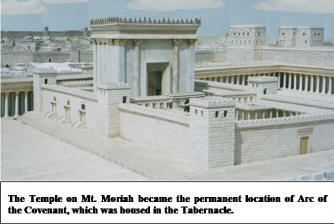 In
chapter 8, we see Jesus Christ who after the type of Melchizedek
is the High Priest of the New Covenant. Melchizedek, was a type
of Christ, a foreshadowing, preparing the way for the coming of the
Messiah who would be both Priest and King.
In
chapter 8, we see Jesus Christ who after the type of Melchizedek
is the High Priest of the New Covenant. Melchizedek, was a type
of Christ, a foreshadowing, preparing the way for the coming of the
Messiah who would be both Priest and King.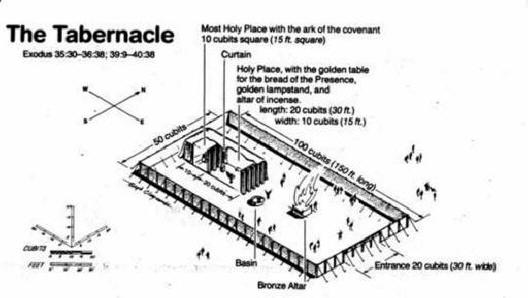
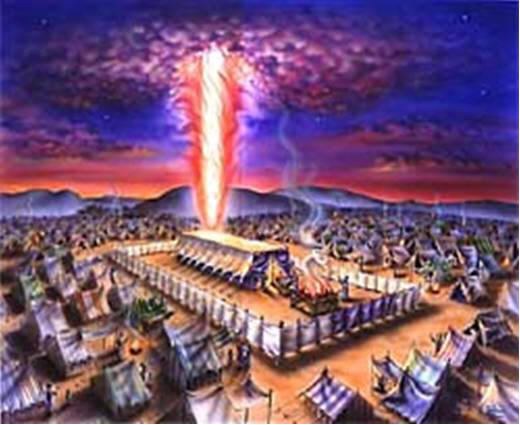 Holy
Spirit:
Holy
Spirit: 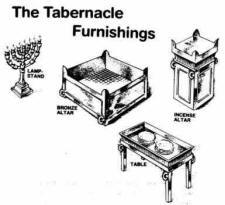
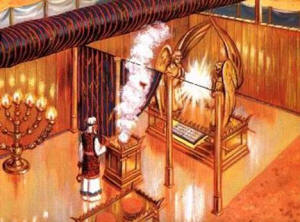 Cleanse:
Cleanse: